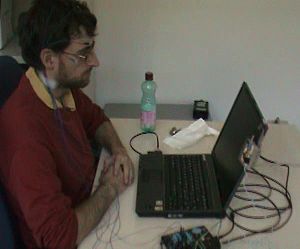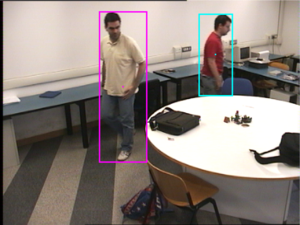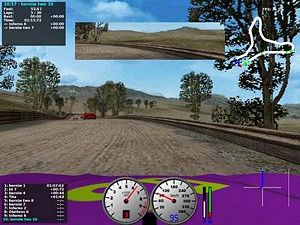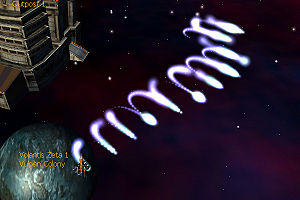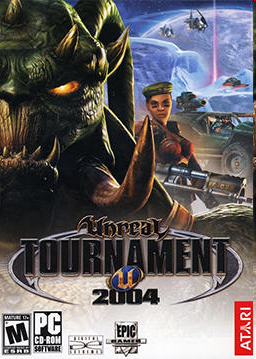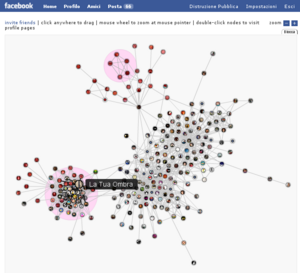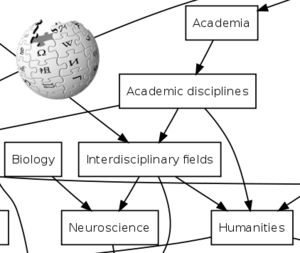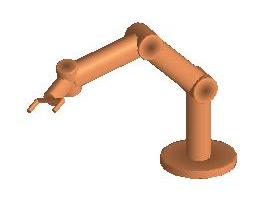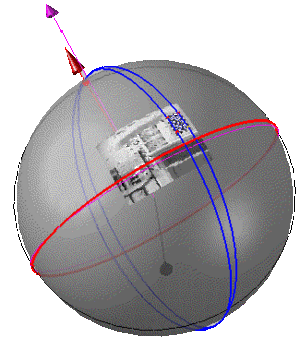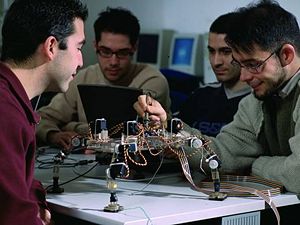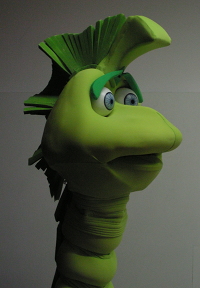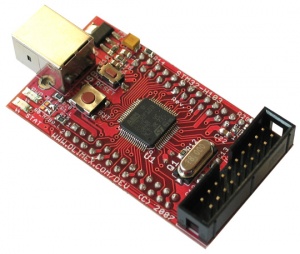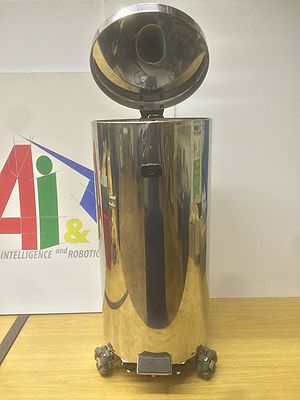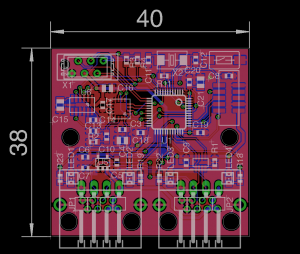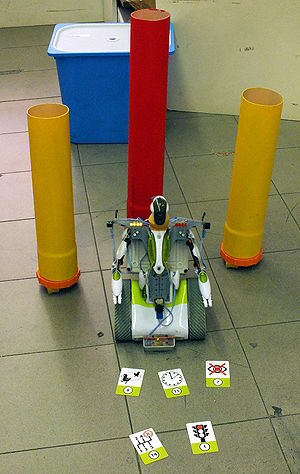Difference between revisions of "First Level Course Projects"
| Line 48: | Line 48: | ||
==== Computational Intelligence and Games ==== | ==== Computational Intelligence and Games ==== | ||
| − | |||
| − | |||
| − | |||
| − | |||
| − | |||
| − | |||
| − | |||
| − | |||
| − | |||
| − | |||
| − | |||
| − | |||
| − | |||
| − | |||
| − | |||
| − | |||
| − | |||
| − | |||
| − | |||
{{Project template | {{Project template | ||
Revision as of 07:25, 29 October 2009
Here you can find a list of project proposals for the courses of "Progetto di Ingegneria Informatica" and "Progetto di Robotica" (5 CFU for each student). See Project Proposals for other kinds of projects and theses.
Contents
BioSignal Analysis
Brain-Computer Interface
| Wiki Page: | Aperiodic visual stimulation in a VEP-based BCI | |
| Title: | Aperiodic visual stimulation in a VEP-based BCI | |
| Description: | Visual-evoked potentials (VEPs) are a possible way to drive the a Brain-Computer Interface (BCI). This projects aims at maximizing the discrimination between different stimuli by using numerical codes derived from techniques of digital telecommunications.
| |
| Tutor: | [[MatteoMatteucci | ]] (, , , , , , , , , , , , , , , , , , … further resultswarning.png
| |
| Start: | 1 October 2009 | |
| Students: | 1 | |
| CFU: | 5 | |
| Research Area: | BioSignal Analysis | |
| Research Topic: | Brain-Computer Interface |
| Wiki Page: | Creation of new EEG training by introduction of noise | |
| Title: | Creation of new EEG training by introduction of noise | |
| Description: | A Brain-Computer Interface (BCI) must be trained on the individual user in order to be effective. This training phase require recording data in long sessions, which is time consuming and boring for the user. The aim of this project is to develop algorithm to create new training EEG (electroencephalography) data from existing ones, so as to speed up the training phase.
| |
| Tutor: | [[MatteoMatteucci | ]] (, , , , , , , , , , , , , , , , , , … further resultswarning.png
| |
| Start: | 1 October 2009 | |
| Students: | 1 - 2 | |
| CFU: | 5 - 20 | |
| Research Area: | BioSignal Analysis | |
| Research Topic: | Brain-Computer Interface |
| Wiki Page: | Driving an autonomous wheelchair with a P300-based BCI | |
| Title: | Driving an autonomous wheelchair with a P300-based BCI | |
| Description: | This project pulls together different Airlab projects with the aim to drive an autonomous wheelchair (LURCH) with a BCI, through the development of key software modules. Depending on the effort the student is willing to put into it, the project can grow to a full experimental thesis. | |
| Tutor: | [[MatteoMatteucci | ]] (, , , , , , , , , , , , , , , , , , … further resultswarning.png
| |
| Start: | 1 November 2008 | |
| Students: | 1 | |
| CFU: | 5 - 20 | |
| Research Area: | BioSignal Analysis | |
| Research Topic: | Brain-Computer Interface |
| Wiki Page: | Multimodal GUI for driving an autonomous wheelchair | |
| Title: | Multimodal GUI for driving an autonomous wheelchair | |
| Description: | This project pulls together different Airlab projects with the aim to drive an autonomous wheelchair (LURCH - The autonomous wheelchair) with a multi modal interface (Speech Recognition, Brain-Computer Interface, etc.), through the development of key software modules. The work will be validated with live experiments.
| |
| Tutor: | [[MatteoMatteucci | ]] (, , , , , , , , , , , , , , , , , , … further resultswarning.png
| |
| Start: | 1 October 2009 | |
| Students: | 1 - 2 | |
| CFU: | 5 - 10 | |
| Research Area: | BioSignal Analysis | |
| Research Topic: | Brain-Computer Interface |
| Wiki Page: | Real-time removal of ocular artifact from EEG | |
| Title: | Real-time removal of ocular artifact from EEG | |
| Description: | In a Brain-Computer Interface (BCI) based on electroencephalogram (EEG), one of the most important sources of noise is related to ocular movements. Algorithms have been devised to cancel the effect of such artifacts. The project consists in the in the implementation in real time of an existing algorithm (or one newly developed) in order to improve the performance of a BCI.
| |
| Tutor: | [[MatteoMatteucci | ]] (, , , , , , , , , , , , , , , , , , … further resultswarning.png
| |
| Start: | 1 October 2009 | |
| Students: | 1 - 2 | |
| CFU: | 2.5 - 5 | |
| Research Area: | BioSignal Analysis | |
| Research Topic: | Brain-Computer Interface |
Computer Vision and Image Analysis
| Title: | Video surveillance system for indoor Environment | |
|---|---|---|
| Description: | The goal of this project is to develop a video surveillance system based on background subtraction algorithm. The idea is to use a single static camera to track moving objects in a known environment.
The skills required for this project are:
The project can be turned into a thesis extending the algorithm for camera network. | |
| Tutor: | Matteo Matteucci (matteucci-AT-elet-DOT-polimi-DOT-it) | |
| Start: | Anytime | |
| Number of students: | 2-3 | |
| CFU: | 2.5-15 |
Computational Intelligence and Games
| Title: | AI in Racing Games | |
|---|---|---|
| Description: | TORCS is a state-of-the-art open source racing simulator that represents an ideal bechmark for machine learning techniques. At the same time, Machine Learning techniques could be used to improve the game experience in this kind of games. Several projects and theses are available on this topic, please contact us for additional information.
| |
| Tutor: | Daniele Loiacono (loiacono-AT-elet-DOT-polimi-DOT-it) | |
| Start: | Anytime | |
| Number of students: | 1 to 2 | |
| CFU: | 5-20 |
| Title: | Automatic Content Generation in Computer Games | |
|---|---|---|
| Description: | The generation of customized game content for each player is an attractive direction to improve the game experience in the next-generation computer games. In this scenario, Machine Learning could play an important role to provide automatically such customized game content. Several projects and theses are available on this topic, please contact us for additional information.
Picutre taken from [1]
| |
| Tutor: | Daniele Loiacono (loiacono-AT-elet-DOT-polimi-DOT-it) | |
| Start: | Anytime | |
| Number of students: | 1 to 2 | |
| CFU: | 5-20 |
| Title: | Human-Like AI in Games | |
|---|---|---|
| Description: | Developing a human-like AI is a challenging and fascinating problem from the point of view of the Artificial Intelligence research. At the same time, it is also a significative prolem for the computer games development: playing against humans is generally more exciting than playing against computers.
Our projects and theses on this topic involve two different games: Unreal Tournament 2004 and TORCS. Please contact us for additional information.
| |
| Tutor: | Daniele Loiacono (loiacono-AT-elet-DOT-polimi-DOT-it) | |
| Start: | Anytime | |
| Number of students: | 1 to 2 | |
| CFU: | 5-20 |
Social Software and Semantic Web
| Wiki Page: | A firefox extension for semantic annotations | |
| Title: | A Firefox extension for semantic annotations | |
| Description: | Aim of this project is to develop a Firefox extension, to allow a community of users to annotate resources on the Web using a shared RDF vocabulary.
While browsing the Web, a user should be able to visualize the annotations relative to the page they are visiting, and to add new annotations as well. | |
| Tutor: | [[DavidLaniado | ]] (, , , , , , , , , , , , , , , , , , … further resultswarning.png
| |
| Start: | ||
| Students: | 1 - 2 | |
| CFU: | 5 - 20 | |
| Research Area: | Social Software and Semantic Web | |
| Research Topic: | Semantic Annotations |
| Wiki Page: | Annotation aggregators from social applications | |
| Title: | Annotation aggregators from social applications | |
| Description: | Annotations are metadata published about a resource, such as tags in del.icio.us, comments on stumbleupon.com, or twines on Twine.com. One of the main problems of these annotations is that they are not expressed in a standard format: thus, any tool trying to aggregate information from these sources should be able to access each one of them in a different way.
The purpose of this project is to develop translation tools for different social annotation systems, collect their data in a common format (expressed using an ontology), and show them through a unique user interface, able to display different annotations (i.e. geo coordinates, dates, tags, etc.) in different ways. Moreover, tests and evaluations should be performed on this aggregator to show how efficient the queries are when performed on-the-fly or from an intermediate knowledge base. | |
| Tutor: | [[DavideEynard | ]] (, , , , , , , , , , , , , , , , , , … further resultswarning.png
| |
| Start: | ||
| Students: | 1 - 2 | |
| CFU: | 5 - 20 | |
| Research Area: | Social Software and Semantic Web | |
| Research Topic: | Semantic Annotations |
| Wiki Page: | Extending a search engine with semantic information | |
| Title: | Extending a search engine with semantic information | |
| Description: | We are used to keyword-based search engines, where only documents matching the exact words in the query are retrieved. In a traditional search engine, if you submit the query "a dinosaur in a university in Lombardy" you won't probably find a document containing the phrase "a velociraptor in Politecnico di Milano", even though it's more or less what you were looking for.
Aim of this project is to expand a traditional search engine with semantic information, so that also documents containing words related to the ones in the query can be retrieved. Existing thesauri and ontologies can be used, as well as more dynamic and collaborative sources of knowledge such as user tags and wikipedia pages and categories. Starting points for this work can be the projects "SeQuEx - Semantic Query Expansion" and "Enriching search results with semantic metadata". | |
| Tutor: | [[DavidLaniado | ]] (, , , , , , , , , , , , , , , , , , … further resultswarning.png
| |
| Start: | ||
| Students: | 1 - 2 | |
| CFU: | 5 - 20 | |
| Research Area: | Social Software and Semantic Web | |
| Research Topic: | Semantic Search |
| Wiki Page: | Facebook automatic list suggestion | |
| Title: | Facebook Automatic List Suggestion | |
| Description: | In Facebook each user can create lists of friends (for example: "high school","university","tennis") to better filter information and manage privacy.
Goal of this project is to develop a Facebook application to analyze a user's network of friends and automatically detect groups to suggest lists. | |
| Tutor: | [[DavidLaniado | ]] (, , , , , , , , , , , , , , , , , , … further resultswarning.png
| |
| Start: | ||
| Students: | 1 - 2 | |
| CFU: | 5 - 10 | |
| Research Area: | Social Software and Semantic Web | |
| Research Topic: | Social Network Analysis |
| Wiki Page: | Mining wikipedia categories | |
| Title: | Wikipedia category map | |
| Description: | Wikipedia articles are organized in a hierarchy of categories, manually assigned by users. This process can be considered a huge effort for the collective categorization of human knowledge; the result is a wide and disordered graph which can provide precious information for a variety of applications (natural language processing, information retrieval, ontology building...).
In the project "Wikipedia Category Map" a tool has been developed to extract the graph of Wikipedia categories, to store it in RDF format and to interactively visualize and explore it. Aim of this project is to analyze the resulting graph for the extraction of semantic relationships; for example it is possible to define metrics of distance between topics in the graph, which can be useful for various purposes in information retrieval. | |
| Tutor: | [[DavidLaniado | ]] (, , , , , , , , , , , , , , , , , , … further resultswarning.png
| |
| Start: | 7 July 2009 | |
| Students: | 1 - 2 | |
| CFU: | 5 - 20 | |
| Research Area: | Social Software and Semantic Web | |
| Research Topic: | Semantic Tagging |
| Wiki Page: | Social Network Data Extraction from Online Communities | |
| Title: | Social Network Data Extraction From Online Communities | |
| Description: | With the growth of the Web and the emergence of online communities, a huge amount of data regarding social relationships is now available, that was unthinkable until a few years ago. The network of connections may unveil precious information about communities structures and dynamics and the spreading of information in the Web.
Aim of this project is to design and develop a software tool to extract this kind of information from a single social network platform (decided by the student). It may be required also some kind of analysis or visual representation of the collected data. | |
| Tutor: | [[DavidLaniado | ]] (, , , , , , , , , , , , , , , , , , … further resultswarning.png
| |
| Start: | ||
| Students: | 1 - 2 | |
| CFU: | 5 - 20 | |
| Research Area: | Social Software and Semantic Web | |
| Research Topic: | Social Network Analysis |
| Wiki Page: | Use case design and implementation for semantic annotations | |
| Title: | Use case design and implementation for semantic annotation | |
| Description: | Semantic annotations offer a variety of possibilities to enhance the user experience while browsing the Web. Aim of this project is to propose one scenario in which their usefulness is exploited for a specific community of users. In detail the project requires to design a simple ontology which describes some kind of domain to annotate resources on the Web and implement an interface to query it and insert assertions inside a semantic store (through SPARQL).
One possible example is the annotation of mp3 files available on the Web. They can be classified in genres or associated to datatype properties, such as rating, title, length and release date... also exploiting data already available in http://musicbrainz.org/ | |
| Tutor: | [[DavideEynard | ]] (, , , , , , , , , , , , , , , , , , … further resultswarning.png
| |
| Start: | ||
| Students: | 1 - 2 | |
| CFU: | 5 - 10 | |
| Research Area: | Social Software and Semantic Web | |
| Research Topic: | Semantic Annotations |
| Wiki Page: | Wikipedia Page Social Network | |
| Title: | Wikipedia Page Social Network | |
| Description: | Goal of this project is to study the social network of Wikipedia pages, where two pages are connected if they share at least one main contributor. This social network can be studied to reveal interesting information; for example, it is possible to extract clusters of pages which apparently have nothing in common. A metric of distance between pages in the network can be defined, and compared with other metrics, such as the distance in the category tree or in the hyperlink graph. | |
| Tutor: | [[DavidLaniado | ]] (, , , , , , , , , , , , , , , , , , … further resultswarning.png
| |
| Start: | ||
| Students: | 1 - 2 | |
| CFU: | 5 - 20 | |
| Research Area: | Social Software and Semantic Web | |
| Research Topic: | Social Network Analysis |
Machine Learning
Robotics
| Title: | Simulation of 6-DOF Robot Manipulator | |
|---|---|---|
| Description: | The goal of this project is to develop a simulator for a 6-DOF robot manipulator, using the ode (open dynamics engine) library for simulating the rigid body dynamics. The project involves three different phases:
This project allows to put into practice what has been explained during the first part of the course of Robotics. The project can be turned into a thesis, by using the simulated manipulator to perform some learning experiments. | |
| Tutor: | Marcello Restelli (restelli-AT-elet-DOT-polimi-DOT-it) | |
| Start: | Anytime | |
| Number of students: | 2-3 | |
| CFU: | 10-15 |
| Title: | Calibration of IMU-camera system | |
|---|---|---|
| Description: | This work is about the problem to calibrate a system composed by an XSense
Inertial Measurement Unit and a Fire-i Camera. The pro ject will be focus on the problem to estimate both unknown rotation between the two devices and the extrinsic/intrinsic parameters of the camera. This algorithm allows to use the system for SLAM or robotics applications, like a wereable device for autonomous navigation or augmented reality.
| |
| Tutor: | Matteo Matteucci, Davide Migliore | |
| Start: | Anytime | |
| Number of students: | 1 | |
| CFU: | 5-20 |
| Title: | Humanoid robotics | |
|---|---|---|
| Description: | this project is about developing various functions of humanoids, in particular related to sensing and cognition for manipulation. Possible specific projects are:
All the projects can be turned into a thesis. | |
| Tutor: | Giuseppina Gini(gini-AT-elet-DOT-polimi-DOT-it) | |
| Start: | Anytime | |
| Number of students: | 4-5 | |
| CFU: | 5-20 |
| Title: | Legged locomotion | |
|---|---|---|
| Description: | The proposed projects in the area of walking robots will improve the performances of on-going systems.
All the projects can be turned into a thesis. | |
| Tutor: | Giuseppina Gini (email) | |
| Start: | Anytime | |
| Number of students: | 2-5 | |
| CFU: | 5-20 |
| Wiki Page: | BringMeHome | |
| Title: | BringMeHome | |
| Description: | ||
| Tutor: | [[AndreaBonarini | ]] (, , , , , , , , , , , , , , , , , , … further resultswarning.png
| |
| Start: | 30 March 2013 | |
| Students: | 1 - 2 | |
| CFU: | 2 - 20 | |
| Research Area: | Robotics | |
| Research Topic: | E-2? - A robot for exhibitions |
| Wiki Page: | CAN Bus bootloader for STM32 microcontrollers | |
| Title: | CAN Bus bootloader for STM32 microcontrollers | |
| Description: | JOINT PROJECT with the Embedded Systems group (contact: Patrick Bellasi http://home.dei.polimi.it/bellasi/)
In order to speed up the development and the maintenance of embedded applications, a way to update the firmware on a microcontroller without the need of connecting cables or programmers can be very handy. We are developing a framework for rapid prototyping of low-cost robots, with smart devices that exchange data on a CAN bus network. The CAN bus bootloader is one of the components we need for this project, enabling remote firmware upgrades of all the devices connected to the CAN network. This project aims to develop a CAN bus bootloader for STM32 ARM Cortex-M3 microcontrollers, and eventually for other architectures. | |
| Tutor: | [[AndreaBonarini | ]] (, , , , , , , , , , , , , , , , , , … further resultswarning.png
| |
| Start: | 1 March 2012 | |
| Students: | 1 - 2 | |
| CFU: | 2 - 5 | |
| Research Area: | Robotics | |
| Research Topic: | Robot development |
| Wiki Page: | Designing Living Objects | |
| Title: | Designing Living Objects | |
| Description: | The aim of this activity is to investigate how one or more objects in an antropic environment (home, office, hospital) can be designed and implemented to have a character and to move, having nice interactions with people. The work to be done concerns the analysis, definition, design and implementation of at least one of these objects. | |
| Tutor: | [[AndreaBonarini | ]] (, , , , , , , , , , , , , , , , , , … further resultswarning.png
| |
| Start: | 15 October 2017 | |
| Students: | 1 - 2 | |
| CFU: | 5 - 20 | |
| Research Area: | Robotics | |
| Research Topic: | Living Objects |
| Wiki Page: | Embedded registers view plug-in for Eclipse | |
| Title: | Embedded registers view plug-in for Eclipse | |
| Description: | JOINT PROJECT with the Embedded Systems group (contact: Patrick Bellasi http://home.dei.polimi.it/bellasi/)
When developing embedded applications it is frequently needed to look at *hardware register content* in order to *debug the code*. All commercial development suites offer register views that show their contents as well as the meaning of each bit. Open source development solutions currently lack this feature, meaning that you have to look to the correct memory location and map the content to the corresponding register bits manually. This seems to be one of the most limiting issues when developing embedded application using open source solutions. This project aims to fill this gap, developing an Eclipse plug-in that shows the register contents in a tree viewer, like most commercial suites do. | |
| Tutor: | [[AndreaBonarini | ]] (, , , , , , , , , , , , , , , , , , … further resultswarning.png
| |
| Start: | 30 May 2011 | |
| Students: | 1 - 2 | |
| CFU: | 2 - 5 | |
| Research Area: | Robotics | |
| Research Topic: | Robot development |
| Wiki Page: | R2P IMU firmware development | |
| Title: | Embedded Inertial Measurement Unit for Unmanned Aerial Vehihcles | |
| Description: | We have developed the electronics of an Inertial Measurement Unit based on an ARM microcontroller to be integrated on an autonomous embedded aerial platform. The IMU has already some attitude heading reference system (AHRS) code implemented, but we are interested in:
Material
Expected outcome:
Required skills or skills to be acquired:
| |
| Tutor: | [[AndreaBonarini | ]] (, , , , , , , , , , , , , , , , , , … further resultswarning.png
| |
| Start: | 1 January 2015 | |
| Students: | 1 - 2 | |
| CFU: | 2 - 20 | |
| Research Area: | Robotics | |
| Research Topic: | Robot development |
| Wiki Page: | Robot Games | |
| Title: | Robot Games | |
| Description: | Projects may include the design of an interactive game on an existing or a new robot, and its evaluation. These projects allow to experiment with real mobile robots and interaction devices. Some games may be designed for disabled children. The project can be considered a MS thesis if it can produce a new game and, possibly, a new robot, and includes adapting the behavior of the robot to the player. | |
| Tutor: | [[AndreaBonarini | ]] (, , , , , , , , , , , , , , , , , , … further resultswarning.png
| |
| Start: | ||
| Students: | 1 - 2 | |
| CFU: | 2 - 20 | |
| Research Area: | Robotics | |
| Research Topic: | Robogames |
| Wiki Page: | Scripting language on embedded platforms | |
| Title: | Scripting language on embedded platforms | |
| Description: | JOINT PROJECT with the Embedded Systems group (contact: Patrick Bellasi http://home.dei.polimi.it/bellasi/)
When developing embedded applications it is common the need to test some algorithm in some fast way, without to re-program the whole firmware every time. PAWN (http://www.compuphase.com/pawn/) is a *simple and lightweight scripting language with a C-like syntax*. Execution speed, stability, simplicity and a small footprint were essential design criteria for both the language and the abstract machine, making PAWN suitable for embedded applications. This project aims to port the abstract machine to ARM Cortex-M3 microcontrollers, add a set of functions to interface with the underlying hardware peripherals and then to embed it as ChibiOS/RT (http://www.chibios.org) thread. | |
| Tutor: | [[AndreaBonarini | ]] (, , , , , , , , , , , , , , , , , , … further resultswarning.png
| |
| Start: | 30 May 2011 | |
| Students: | 1 - 2 | |
| CFU: | 2 - 5 | |
| Research Area: | Robotics | |
| Research Topic: | Robot development |
| Wiki Page: | Soccer Robots | |
| Title: | Soccer Robots | |
| Description: | Projects are available in different areas:
The project can be turned into a thesis by facing different problems in depth. | |
| Tutor: | [[MarcelloRestelli | ]] (, , , , , , , , , , , , , , , , , , … further resultswarning.png
| |
| Start: | 1 January 2009 | |
| Students: | 1 - 2 | |
| CFU: | 5 - 20 | |
| Research Area: | Robotics | |
| Research Topic: | Robot development |


